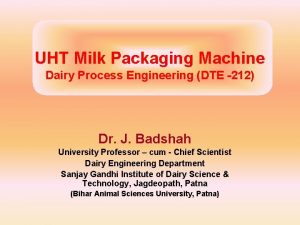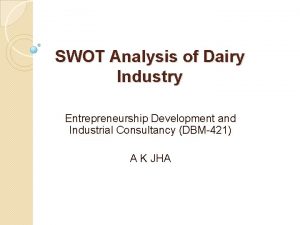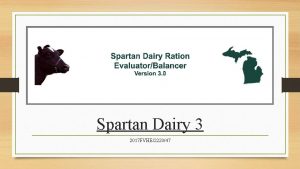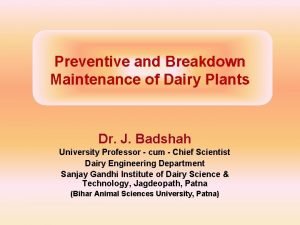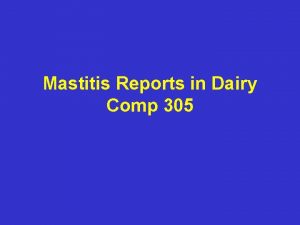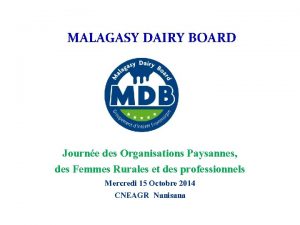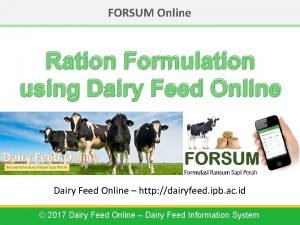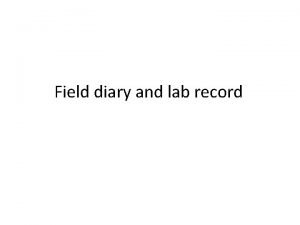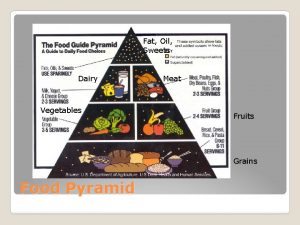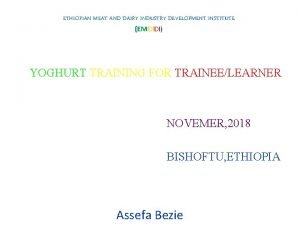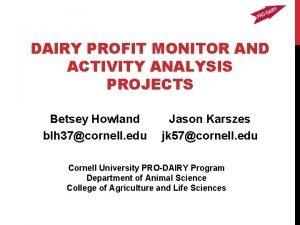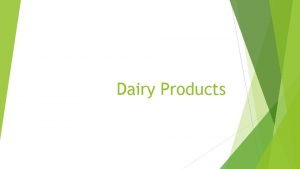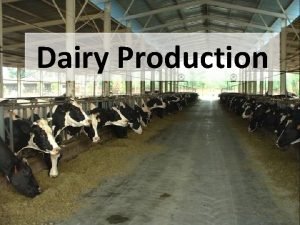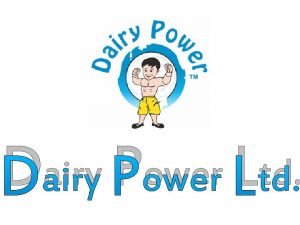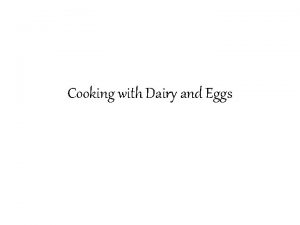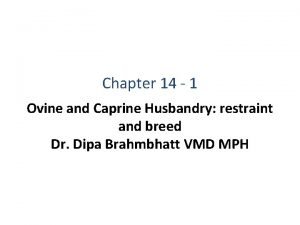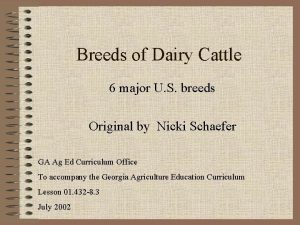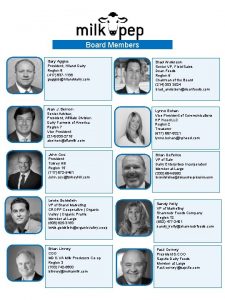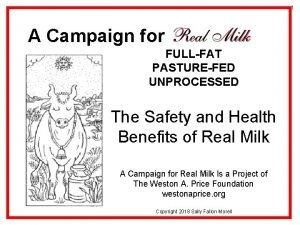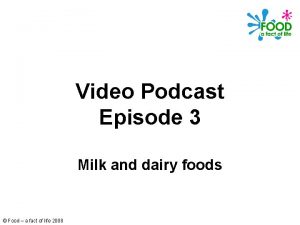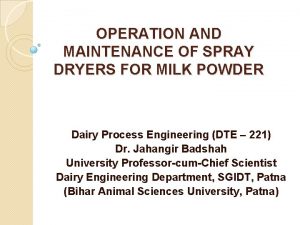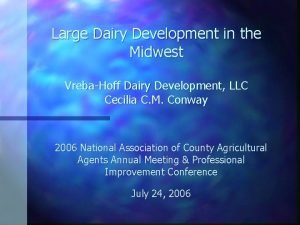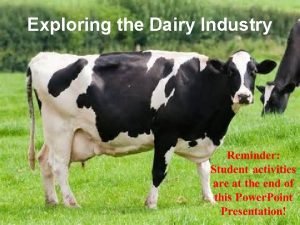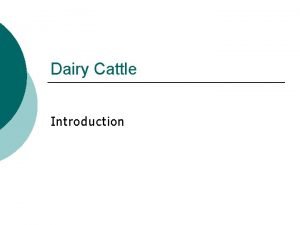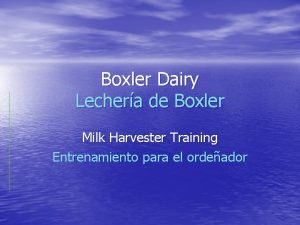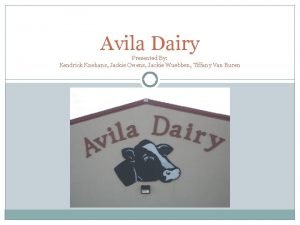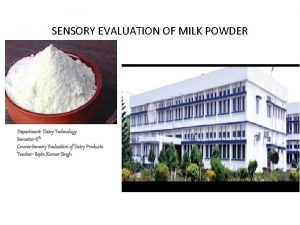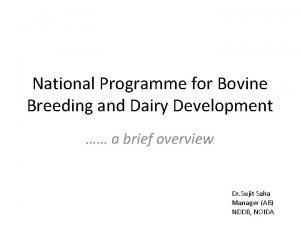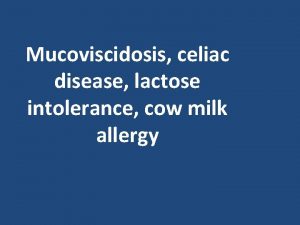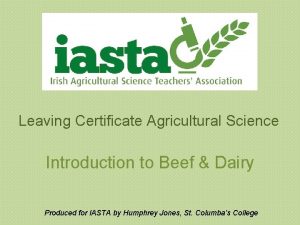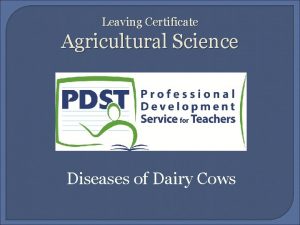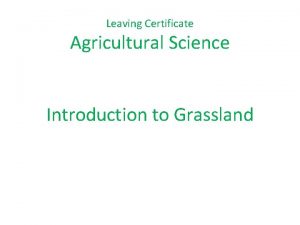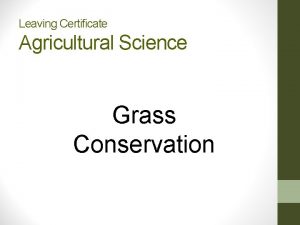Leaving Certificate Agricultural Science Introduction to Dairy Introduction















































- Slides: 47

Leaving Certificate Agricultural Science Introduction to Dairy

Introduction • In the past cattle were bred for three main reasons: 1. To provide milk 2. To provide beef 3. To aid in farming – pulling ploughs etc. • The cattle breeds were then developed to perform one or more of the above operations. • Today, the farmer can choose which breed he feels is most appropriate to the farmers needs.

Introduction - 2 • The three types of cattle operations in Irish farms at the moment are • Pure Dairy farming • Pure Beef Production • Dairying with beef production (Most common) • Pure Dairy farming is very rare in Ireland at the moment. • Since dairy animals must calve each year to produce milk, there would be a surplus of dairy animals.

Introduction - 3 • This is because only some of the calves would be needed as herd replacements or could be sold as breeding stock. • So most of the calves are fattened and sold as beef. • Therefore it is important that the farmer chooses his breed carefully. • Also the cow, after her potential as a dairy animal is finished, would also be slaughtered for beef. • For this reason most dairy farms in Ireland are dual purpose [and the most common breed is Friesian (more later)]

The Main Dairy Breeds The Friesian: • 90% of all Irish Dairy animals are Friesians and is without question the most popular breed with Irish farmers • The Friesian is a large animal, distinctive black and white coat, and weighing up to 700 kg. • The are characterised by producing large milk yields but with a low milk solids content. • The Friesian is a fast growing, beefy animal, well suited to continental beef market. • Friesians are examples of a dual purpose breed.


The Main Dairy Breeds - 2 The Jersey: • The Jersey is so called because of where it was originally bred. • They are small animals and are not dual purpose i. e. they are not suitable for beef production. • Jersey milk is considered very highly due to its high protein and butterfat content, but generally speaking the Jersey’s yield would be lower than that of the Friesian. • The Jersey cow can however frequently calve at just two years and may have up to 10 or 11 lactations. • They are also quite useful for beef breeding and can be used as mothers to Charolais calves.


The Main Dairy Breed - 3 The Kerry Cow • It is the oldest cattle breed in Ireland, and indeed one of the oldest in the world. • The mature Kerry cow weighs around 450 kg and are similar to Aberdeen Angus but are smaller and have horns. • The Kerry cow has quite a low milking potential, but is very productive in poor, harsh conditions.


The Main Dairy Breeds - 4 The Holstein • The Holstein looks the same as the Friesian, in coat colour only, but a little taller. • These are similar to Jersey cows as they are pure dairy animals, and are not at all suitable to beef production. • They are also being crossed with Friesians to produce dual purpose off spring but these are not as effective as pure Friesian.


The main dairy breeds 5 Ayrshire • Originates from Scotland • Has red and white markings • Characteristics include easy calving and longevity • Milk has a moderate butterfat content and high in protein

Ayrshire

Shorthorn • Has 3 distinct colours: Red, Roan (patches of red and white) and White • Dual purpose breed • Blocky build which allows them have a good beef carcase

Montbelliard • Two distinct coat colours: red and white • Dual purpose breed • Very hardy, well suited to harsh climates

Production systems in Dairy Farming • Of the 6 billion litres of milk produced in Ireland per annum, approx 10% is used for direct consumption • The remaining 90% is processed in creameries for the production of butter, cheese and other dairy products • The two systems are compared in following table

Liquid Farm Creamery Farm Year round calving Spring calving Uniform supply of milk Break in the milk supply The emphasis is on quantity Emphasis is both quantity and quality High production costs in Largely based on grass so relation to feeding less costly Bull calves used for the Bull calves slaughtered for veal export trade beef or exported for veal

Name Age Sex Stage Calf Up to 6 months old Male/Female Newborn Weanling 6 – 12 months Male/Female Yearling Over 1 year old Male/Female Heifer Day 1+ Female Cow Over 2 years old Female Animal weaned from mother Anwimal over 12 months old Immature, has not yet calved After the start of 1 st lactation Suckler cow Over 2 years old Female Had at least one calf which is suckling mother Bullock/Steer Over 6 months old Male Castrated male Bull Day 1+ Male Uncastrated male Store Over 12 months old Male An animal which requires an extended period to finish

Some common facts • Birth and Puberty • A female calf (destined for dairying) weigh approx 40 kg at birth. • If reared correctly, she should reach puberty at 1 year, weighing 250 kg. • Oestrous Cycle • The length of the oestrous cycle of a cow is 21 days and it lasts an average of 18 hours. • The gestation period of the dairy cow is 283 days (approx 9. 5 months)

Lactation • A cow commences producing milk as soon as she has a calf. • If the cow is used to suckle calves, then she may continue to produce milk for up to 2 years. • If she becomes pregnant (in-calf) she will go dry two months before calving. • In commercial milk production, the aim is have the cow calve once a year, around the same time each year. • This means that she will be milking 10 months of the year or approx 305 days.

Drying off cows • Reasons for drying off cows • Allows time for the tissue in the udder to repair itself • Allows cow to regain body condition • It completes the development of her calf in the uterus

Lactation Yields The milk yield of the cow depends on the breed. Holstein: 5800 kg per year Jersey: 3400 kg per year Ayreshire: 4000 kg per year Friesian: 5000 kg per year. Dairy Shorthorn: 4000 kg per year. These vary significantly even amongst individual cows – A Friesian may vary from 2000 kg a year to 12000 kg of milk a year. These yields have also increased over the last number of years in Ireland due to better selection of breeds.

Lactation Curve • A lactation curve plots the milk production of a dairy cow over the course of her lactation until she is dried off • Milk production increases from the start of lactation until a peak yield is reached four to six weeks after calving. • A high peak yield normally results in a higher total milk yield • The total lactation yield can be estimated using following formula Total Lactation yield = Lactation peak x 200 (average) Total Lactation yield = Lactation peak x 220 (high)

Lactation Curve • In order for a cow to reach her potential peak yield, she must be on a high plane of nutrition, i. e. good quality silage, concentrates and grass. • The peak yield also dependent on age (see next slide) • After a cow reaches her peak yield, her milk yield will start to decline • The rate at which her milk yield declines is known as persistence

Lactation and age • Lactation Yields also vary with a cows age: Age Lactation No % Of Max Yield 2 1 75 3 2 85 4 3 90 5 4 95 6 5 100 The yield of the average dairy cow decreases after the 5 th lactation.

Lactation curve

Frequency of Milking • Studies have shown that frequently milked cows produce more milk than those milked irregularly. • Therefore a cow milked four times a day will produce more milk than a cow milked twice – it will work to demand. • BUT milking more than twice a day is uneconomical and leaves cows more prone to disease such as mastitis. • With milking twice daily, the ideal milking interval is 12 hours. This gives the cow less stress and will get the highest yields. • But this gives the farmer a very long working day and is uncommon. The most common intervals are 14/10 or 13/11 hour intervals.

Milk composition • Milk is a suspension of protein, fat and other solids in water • Milk is approximately • 87. 5% water • 3. 8% butterfat • 8. 6% solids non – fat (SNF) • Of Which • 4. 6% lactose • 3. 3% protein • 0. 8% vitamins and minerals

• The average milk composition is as follows: Milk Total Milk Solids 12. 5% Fat 3. 8% Lactose 4. 6% Water 87. 5% Solids Non Fat (SNF) 8. 7% Protein (Casien) 3. 1% N Protein 0. 2% Vitamins & Minerals 0. 8%

Factors which affect Milk Composition • Protein content: • This is affected by breed of cow, heifers should be chosen from parents with high protein yields. • Feeding concentrates along with good quality grass or silage will also help increase protein content • Butterfat content: • Jersey cows have a very high fat content • Older cows produce less fat in their milk • The Strippings which is the very last bit of milk taken from the cow after milking has a very high fat content.

Continued • Feeding • Quality milk needs quality feeding, so good grassland management, high quality silage and efficient concentrate feeding are important • Animal health • Ill- health and disease, e. g. mastitis can affect composition of milk • Antibiotics can remain in the cows system for 3 – 4 days and the milk from this cow can not be supplied to the creamery

Continued • Stage in Lactation • Butterfat, Lactose and protein percentage vary depending on the stage of lactation • Cell counts • A high somatic cell count (SCC) indicates the presence of sub clinical mastitis • SCC’s are higher in older cows as well as cows with mastitis • Cooling milk • Efficient cooling and storage of milk is essential to prevent bacteria multiplying and contaminating milk

Milk Quality Standards • Raw milk collected from farms must comply with EU regulations • The creameries carry out the following tests on milk • Bacterial test – Total Bacteria Count (TBC) • Sample of milk taken, placed on growth medium and incubated for 3 days • The no. of bacteria per ml of milk is read. • TBC must not exceed 100, 000 over a two month geometric average

Continued • Somatic Cell Test • An electronic cell counter counts white blood cells. A high SCC reading indicates sub clinical mastitis • SCC must not exceed 400, 000 on three-month geometric averages. • Thermoduric Test. • This counts the no. of thermo resistant bacteria • Must not exceed 1000 per ml. • Mild Temperatures • Temperature must be less than 6 o. C at collection

Continued • Antibiotic test • Carried out to test for presence of antibiotics • Excess Water • Where excess water is detected, a price adjustment will apply on the volume calculated • Sediment test • Milk must be free from particles and sediment

Husbandry and maintaining high hygiene standards in milking • Maintain clean housing, cubicle beds, dairy parlour and housing yard • Wash cow’s udders and teats • Check for mastitis • Treat mastitis • Teat dip after milking • Ensure fly control • Filter milk • Wash the bulk tank and milk line regularly • Ensure proper cooling of milk before it enters the bulk tank and refrigerate milk at <4 o. C

Factors which affect composition of cow’s milk • The age of the cow • The quality of feed • The stage in lactation • Breed of cow • Time of year • Time of milking • A higher somatic cell count in older animals (indicator of quality of mik)

The Cow’s Udder • Milk is produced by specialised cells in the udder of a cow. • They udder is located underneath the abdomen, near the hind legs • Consists of 4 quarters, each completely separated from one another. This can be an advantage should the udder become infected with diseases such as mastitis as it is contained in one quarter and doesn’t spread. • Most of the milk is produced near the hind quarters which are bigger

Udder Continued • Suspensory ligaments are the muscular support for the udder which can hold up to 40 Kg of milk • The internal structure of the udder is glandular tissue consisting of millions of milk producing cells called alveoli. • Each alveolus is a cavity surrounded by muscles, blood capillaries and cells which secrete the milk.

The milking process • When the udder is stimulated, e. g. when the calf feeds or when cow is milked, a message is sent to the brain • The pituitary gland in the brain responds by secreting a hormone called oxytocin which causes contraction of the muscles of the alveoli and secretion of milk into the cavities. • From there the milk travels out of the udder through the teat canals. • This whole process is known as “milk let down” and takes about 6 – 10 minutes

The Milking Machine Vacuum Pump • Creates a vacuum which is used to: • Transfer milk to the receiving vessel • To perform the milking process • To transport detergent during the cleaning process. 2. Vacuum Line • Transmits the vacuum to the milking clusters and to the milking line. 3. Vacuum Regulator • Maintains the vacuum at a constant level 1.


4. 5 6 The Milking Machine Pulsator 1. This disrupts the vacuum in the outside of the teat cup (in the cluster) 2. This squeezes in the rubber cup and performs the milking action. Cluster and Teat Cup 1. This is attached to the cows udder during milking Milk Line 1. This line transports the milk from the clusters to the receiving vessel 2. There may be recording jars on each line to measure yields. 3. Milk may be rejected at the recording jar.

7. Milk Pump Transmits milk from the receiving vessel to the bulk tank. 8. Cooler Milk passes through the cooler is cooled from 30 o. C to around 12 o. C 9. Bulk Tank Milk is stored here before being transported to the creamery. 10. Wash line Detergent is flushed through the clusters, milk line and cooler during the cleaning process.


 History syllabus leaving cert
History syllabus leaving cert Primary leaving certificate
Primary leaving certificate Leaving certificate
Leaving certificate Science is my favorite subject because
Science is my favorite subject because Introduction of dairy products
Introduction of dairy products Science fusion digital lessons
Science fusion digital lessons Cs princeton
Cs princeton Uht milk packaging material
Uht milk packaging material Dairy food pyramid
Dairy food pyramid Swot analysis of dairy farming
Swot analysis of dairy farming Sundale dairy
Sundale dairy Spartan dairy
Spartan dairy Cadbury life cycle
Cadbury life cycle Operation and maintenance for dairy plant
Operation and maintenance for dairy plant Dairy comp 305 price
Dairy comp 305 price Malagasy dairy board
Malagasy dairy board Dairy feed ipb
Dairy feed ipb Food groups for grade 3
Food groups for grade 3 Food pyramid carbohydrates fats proteins
Food pyramid carbohydrates fats proteins Importance of field diary slideshare
Importance of field diary slideshare Dairy meat fruit vegetables and grains
Dairy meat fruit vegetables and grains Emdidi
Emdidi Dairy profit monitor
Dairy profit monitor Dairy foods list
Dairy foods list Ffa cheese identification
Ffa cheese identification Objectives of dairy industry
Objectives of dairy industry Dairy power ltd saikheda
Dairy power ltd saikheda How to prepare dairy products for cooking
How to prepare dairy products for cooking Ovine and caprine
Ovine and caprine 6 breeds of dairy cattle
6 breeds of dairy cattle Hiland dairy ceo
Hiland dairy ceo Extensive farming definition ap human geography
Extensive farming definition ap human geography Bestmilk a typical profit maximizing
Bestmilk a typical profit maximizing Wasteland dairy framework
Wasteland dairy framework Washington state dairy council
Washington state dairy council Dairy foods list
Dairy foods list Dairy spray dryers
Dairy spray dryers Vreba hoff dairy
Vreba hoff dairy Vreba hoff dairy
Vreba hoff dairy Diary entry tense
Diary entry tense Dirty jobs dairy cow midwife worksheet answers
Dirty jobs dairy cow midwife worksheet answers Dairy process engineering
Dairy process engineering Boxler dairy farm
Boxler dairy farm Avila dairy equipment
Avila dairy equipment Sensory evaluation of dairy products
Sensory evaluation of dairy products Npbbdd
Npbbdd Milk for toddlers with milk allergynon dairy
Milk for toddlers with milk allergynon dairy Diary writing for grade 5
Diary writing for grade 5







